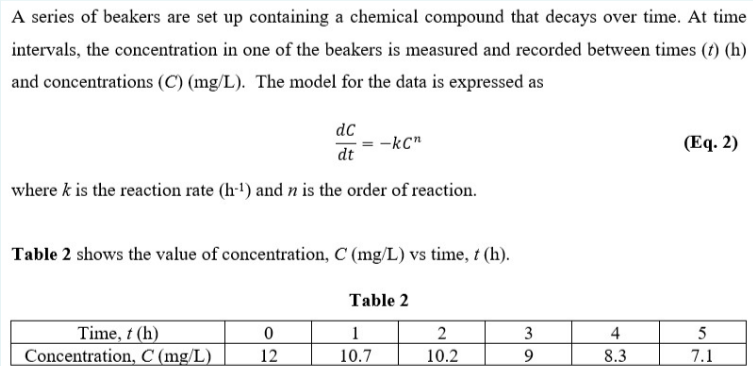A series of beakers are set up containing a chemical compound that decays over time. At time intervals, the concentration in one of the beakers is measured and recorded between times (t) (h) and concentrations (C) (mg/L). The model for the data is expressed as dc dt where k is the reaction rate (h-¹) and n is the order of reaction. Table 2 shows the value of concentration, C (mg/L) vs time, t (h). Time, t (h) Concentration, C (mg/L) -kcn 0 12 Table 2 1 10.7 2 10.2 3 39 9 4 8.3 (Eq. 2) 5 7.1
A series of beakers are set up containing a chemical compound that decays over time. At time intervals, the concentration in one of the beakers is measured and recorded between times (t) (h) and concentrations (C) (mg/L). The model for the data is expressed as dc dt where k is the reaction rate (h-¹) and n is the order of reaction. Table 2 shows the value of concentration, C (mg/L) vs time, t (h). Time, t (h) Concentration, C (mg/L) -kcn 0 12 Table 2 1 10.7 2 10.2 3 39 9 4 8.3 (Eq. 2) 5 7.1
Chemistry: Principles and Reactions
8th Edition
ISBN:9781305079373
Author:William L. Masterton, Cecile N. Hurley
Publisher:William L. Masterton, Cecile N. Hurley
Chapter11: Rate Of Reaction
Section: Chapter Questions
Problem 81QAP: The hypothetical reaction QR+Xproductswas monitored at 27C as a function of time. The following...
Related questions
Question
please provide full solution
(a) If k = 0.08 and n = 1.1, predict the value of concentrations from t = 0 h to t = 5 h to the most accurate value.
(b) Calculate the sum of the square of the residual (SSR). where SSR = Σ(Predicted data - Measured data)2

Transcribed Image Text:A series of beakers are set up containing a chemical compound that decays over time. At time
intervals, the concentration in one of the beakers is measured and recorded between times (t) (h)
and concentrations (C) (mg/L). The model for the data is expressed as
dC
dt
where k is the reaction rate (h-¹) and n is the order of reaction.
Table 2 shows the value of concentration, C (mg/L) vs time, t (h).
Time, t (h)
Concentration, C (mg/L)
-kCn
0
12
Table 2
1
10.7
2
10.2
39
9
4
8.3
(Eq. 2)
5
7.1
Expert Solution
This question has been solved!
Explore an expertly crafted, step-by-step solution for a thorough understanding of key concepts.
Step by step
Solved in 7 steps

Knowledge Booster
Learn more about
Need a deep-dive on the concept behind this application? Look no further. Learn more about this topic, chemistry and related others by exploring similar questions and additional content below.Recommended textbooks for you

Chemistry: Principles and Reactions
Chemistry
ISBN:
9781305079373
Author:
William L. Masterton, Cecile N. Hurley
Publisher:
Cengage Learning

Chemistry: Principles and Practice
Chemistry
ISBN:
9780534420123
Author:
Daniel L. Reger, Scott R. Goode, David W. Ball, Edward Mercer
Publisher:
Cengage Learning


Chemistry: Principles and Reactions
Chemistry
ISBN:
9781305079373
Author:
William L. Masterton, Cecile N. Hurley
Publisher:
Cengage Learning

Chemistry: Principles and Practice
Chemistry
ISBN:
9780534420123
Author:
Daniel L. Reger, Scott R. Goode, David W. Ball, Edward Mercer
Publisher:
Cengage Learning


Chemistry: An Atoms First Approach
Chemistry
ISBN:
9781305079243
Author:
Steven S. Zumdahl, Susan A. Zumdahl
Publisher:
Cengage Learning

Chemistry
Chemistry
ISBN:
9781305957404
Author:
Steven S. Zumdahl, Susan A. Zumdahl, Donald J. DeCoste
Publisher:
Cengage Learning

Chemistry for Engineering Students
Chemistry
ISBN:
9781337398909
Author:
Lawrence S. Brown, Tom Holme
Publisher:
Cengage Learning